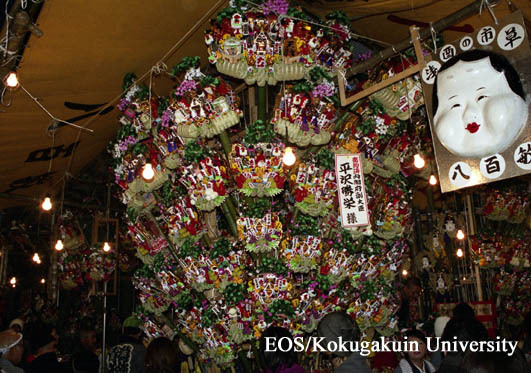- トップ
- Encyclopedia of Shinto
- Tori no ichi
Encyclopedia of Shinto
| Main Menu: | |
| Links: |
詳細表示 (Complete Article)
| カテゴリー1: | 5. Rites and Festivals |
|---|---|
| カテゴリー2: | Rituals in Daily Life |
| Title | Tori no ichi |
| Text | "Cock fair." A festival for Ōtori shrines held on each "day of the cock" in the month of November. The "day of the cock" returns every twelve days, so it usually comes around twice during November. It is said that there will be many fires in those rare years when it returns three times. The Ōtori Jinja located in the city of Sakai (Ōtorikita-machi), Ōsaka Prefecture, is the head shrine for the kami Ōtori myōjin. There are many Ōtori Jinja branch shrines (massha) in and around Tōkyō; the cock fair at the Ōtori Jinja in Tokyo's Asakusa (Taitō-ku Senzoku) neighborhood is particularly famous. Bamboo rakes (kumade) are sold at the shrine that day as lucky charms; decorated with lucky masks (otafuku men), chests of a thousand gold coins (senryōbako), and old-fashioned account books (daifukuchō), they are meant to "rake in" good fortunes. Today Ōtori myōjin is venerated especially by the hotel and restaurant business as a deity for improving one's fortunes, but originally the kami was worshipped by warriors as a tutelary deity of the military arts. Cock fairs are held in over forty locations in Tōkyō, Yokohama, and Saitama, but it is said to have begun as a festival for the deity Ōtori daimyōjin in what was Hanamata village, Kasai-ku (the present-day neighborhood of Hanahata-chō, Adachi-ku, Tokyo). The custom was for people to present live chickens to the deity at the festival and pray for improved fortune, and then set the birds free the next day in front of Asakusa's Kannondō temple. The Hanamata cock fair was once called ōtori ("great cock") or hontori ("main cock"), while that of Asakusa was called shintori ("new cock"). Although the Hanamata Ōtori Shrine was inconvenient for pilgrimages (sankei), the shrine would come alive with people for a short time due to the gaming that took place on the day of the festival. However, gambling was banned during the Meiji period and the Hanamata fair went into decline while the Asakusa shintori began to thrive. — Iwai Hiroshi |

Images of the annual Tori no ichi fair held at Hanazono Jinja in the Shinjuku area. The fair originates with a branch shrine of Ōtori Jinja that is located on the grounds of Hanazono Jinja. Nowadays, the shintai of the defunct Ōtori Jinja is enshrined at the main hall of Hanazono Jinja.
2006年 **月 **日
Ōsawa Kōji




